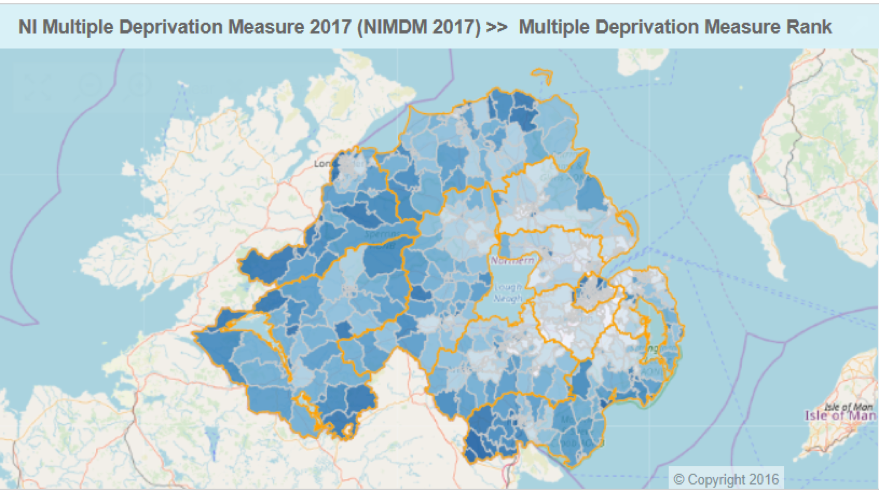Guest blog post by Susan Campbell from Business Services Organisation
Measures of spatial distribution of deprivation have been developed and used in Northern Ireland since the 1970s, and have played a central role in terms of informing the targeting of resources to the most deprived areas in Northern Ireland.
In November 2017 the Northern Ireland Statistics and Research Agency (NISRA) published the Northern Ireland Multiple Deprivation Measure (NIMDM) 20171.
NIMDM 2017 is constructed from 38 different indicators relating to 7 types or ‘domains’ of deprivation: Income Deprivation, Employment Deprivation, Health Deprivation and Disability, Education, Skills and Training Deprivation, Access to Services, Living Environment and Crime & Disorder.
Northern Ireland is split into 890 spatial areas known as Super Output Areas (SOAs), with an average population of around 2,100 people. The indicators in each domain were analysed to produce a domain specific deprivation ranking of the 890 SOAs in Northern Ireland, from 1 (most deprived) to 890 (least deprived). The ranks of the 7 domains were weighted and combined, to provide a ranking of multiple deprivation (MDM) for the 890 SOAs.
Where are the 100 most deprived SOAs according to the Multiple Deprivation Measure?
- 50 are in Belfast, accounting for 29% of its 174 SOAs; the highest proportion of all Local Government Districts
- None of the 67 SOAs in Lisburn & Castlereagh are among the 100 most deprived SOAs
- 5 of the 100 most deprived SOAs are classified as rural
- East, located in Derry City & Strabane, is the most deprived SOA according to the MDM
- 5 of the 10 most deprived SOAs are in Belfast with the other 5 in Derry City & Strabane


In April 2018 NISRA released deprivation statistics for Small Areas2. These allow the identification of smaller pockets of deprivation than the results for Super Output Areas. On average, each Super Output Area can be split into 5 Small Areas.
The new Small Area deprivation statistics can be used to:
- Identify pockets of deprivation – so for example, Small Areas that are amongst the most deprived Small Areas, but they can lie within a Super Output Area that would not be considered most deprived;
- Examine the variation in deprivation rankings of Small Areas within a Super Output Area, a
District Electoral Area, or a Neighbourhood Renewal Area; and
- Identify clusters of similarly deprived Small Areas that cross Super Output Area boundaries.
The MDM is frequently used in projects carried out through the Honest Broker Service. Linkage is done at patient level by mapping the patient postcode to a Super OutputArea using the Central Postcode Directory. The patient postcode is then removed from the dataset as it is a potential identifier. The number of patients in each SOA are considered and if necessary the raw MDM ranking is replaced by a decile or quintile band e.g. decile 1 = most deprived 10% of SOAs i.e. those ranked 1-89. Similarly quintile 1 = most deprived 20% of SOAs i.e. those ranked 1-178. This allows researchers to factor in to any analysis and modelling work whether or not a subject resides in a more deprived area, and if this is of any significance to health outcomes.
One of the NI MIDAS pilots is focused on policies relating to Looked after Children and linking the MDM to the NI MIDAS dataset is likely to be of key importance to policymakers in their analyses. Also, for the first time, scores and rankings of all 38 indicators have been published, which allows users to drill down into specific issues of relevance such as the proportion of children aged under 16 living in income deprived households, and travel times to 20 key services, including (for example) schools, libraries and leisure centres. The Health Deprivation and Disability Domain includes 2 indicators relating to children (low birth weight and children’s dental extractions excluding those carried out by the Community Dental Service). There are 7 child-specific indicators in the Education, Skills and Training Deprivation Domain:
- Pupils with Special Educational Needs (Primary and Post-Primary);
- Absenteeism (Primary and Post-Primary);
- Leavers not entering Further Education, Employment or Training;
- 18-21 year olds not enrolled in Higher or Further Education;
- Leavers with less than 5 GCSEs at A*‑
15 recommendations3 were made following NIMDM 2017. One of relevance to this NI MIDAS pilot was to consider the creation of a child specific multiple deprivation measure. A focus group met in June 2018 to consider this suggestion, and although it was agreed that there was no urgent need, this will be kept under review.
References
1https://www.nisra.gov.uk/sites/nisra.gov.uk/files/publications/NIMDM17-%20with%20ns.pdf
3https://www.nisra.gov.uk/sites/nisra.gov.uk/files/publications/NIMDM17-%20Recommendations.pdf
